The effectiveness of task - based - language teaching in improving ielts reading skill
Abstract. The present paper attempts to emphasise the mutual connection between
testing and teaching in light of evaluating the effectiveness of task-oriented IELTS
activities on the performances of IELTS trainees in their reading test. For this
purpose, the learners in an IELTS preparation center in Hanoi were treated with
IELTS reading materials under the adoption of task-based language teaching
approach (TBLT) for three months. Two instruments to collect data were employed,
namely Pre-IELTS Test and Post-IELTS Test, and a questionnaire. The study
reveals that after the experimental time, the participants’ reading scores improved
considerably.
Keywords: Task-based Language Teaching (TBLT), Reading skill, IELTS.
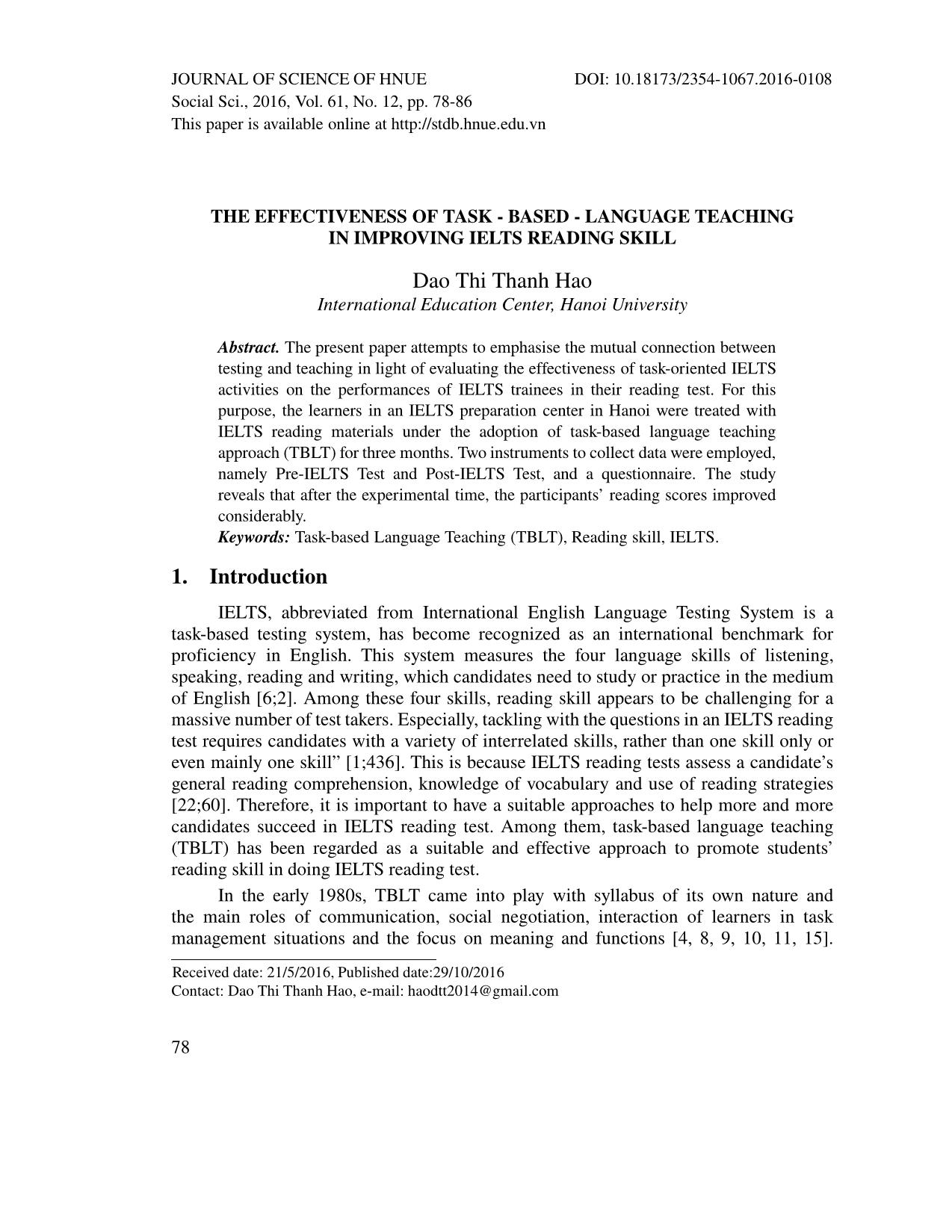
Trang 1

Trang 2
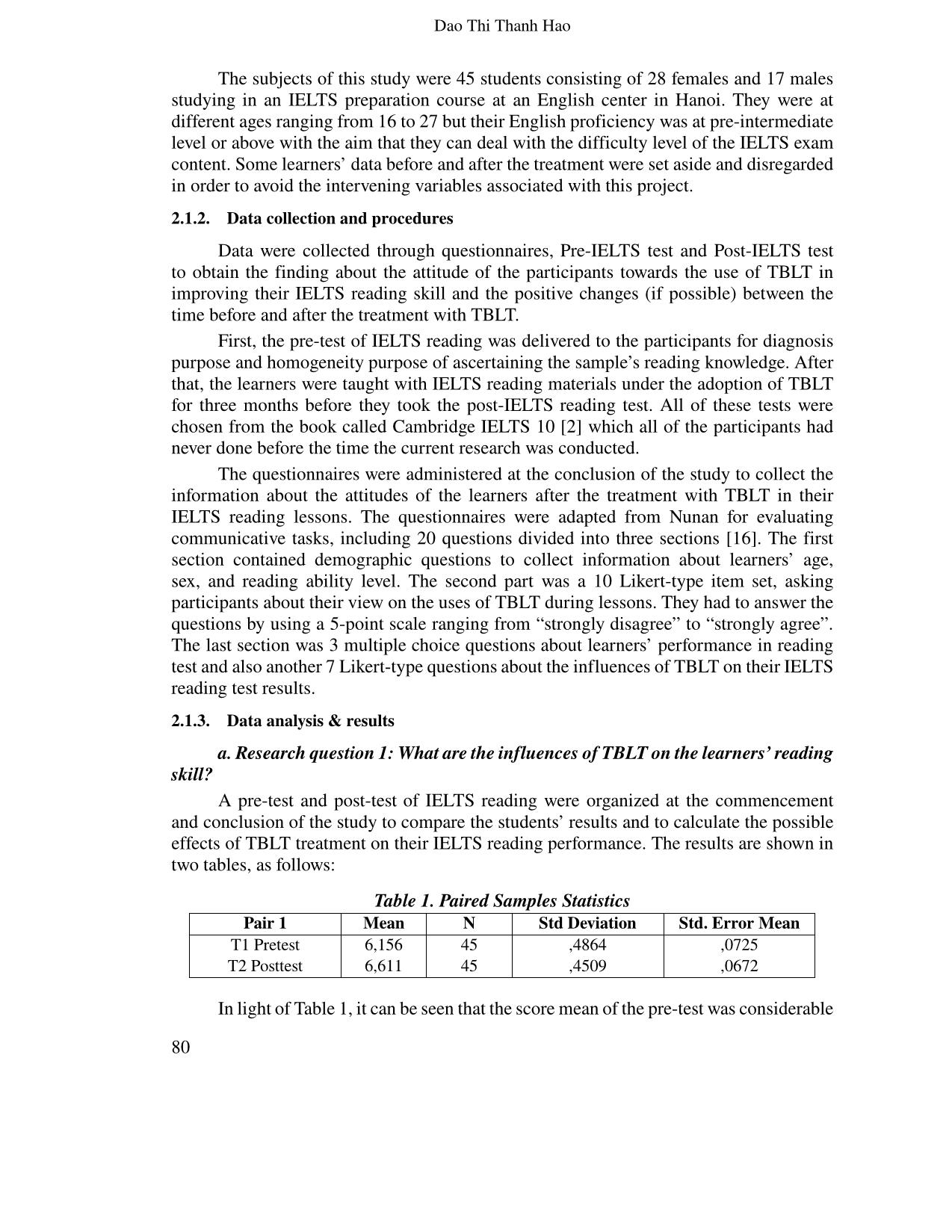
Trang 3
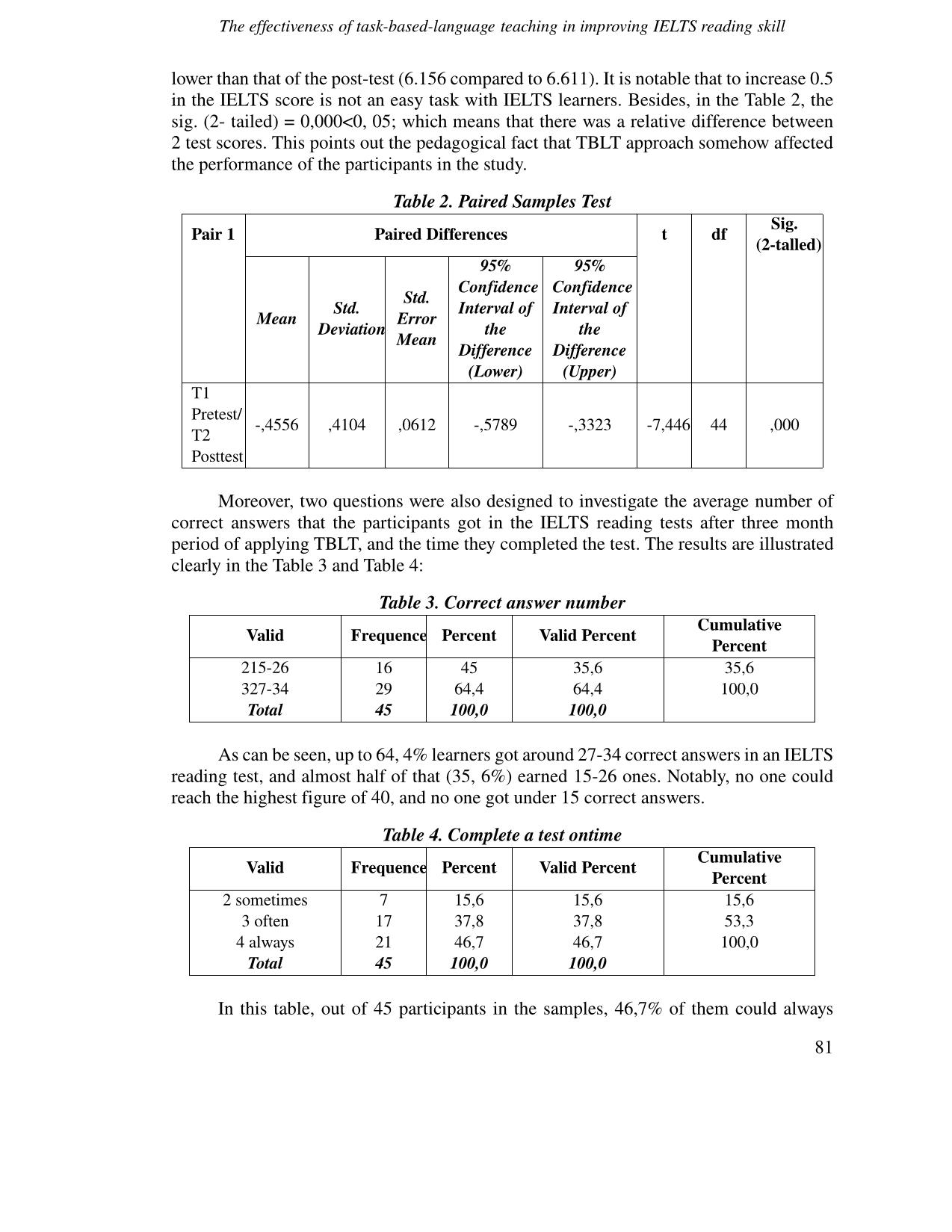
Trang 4
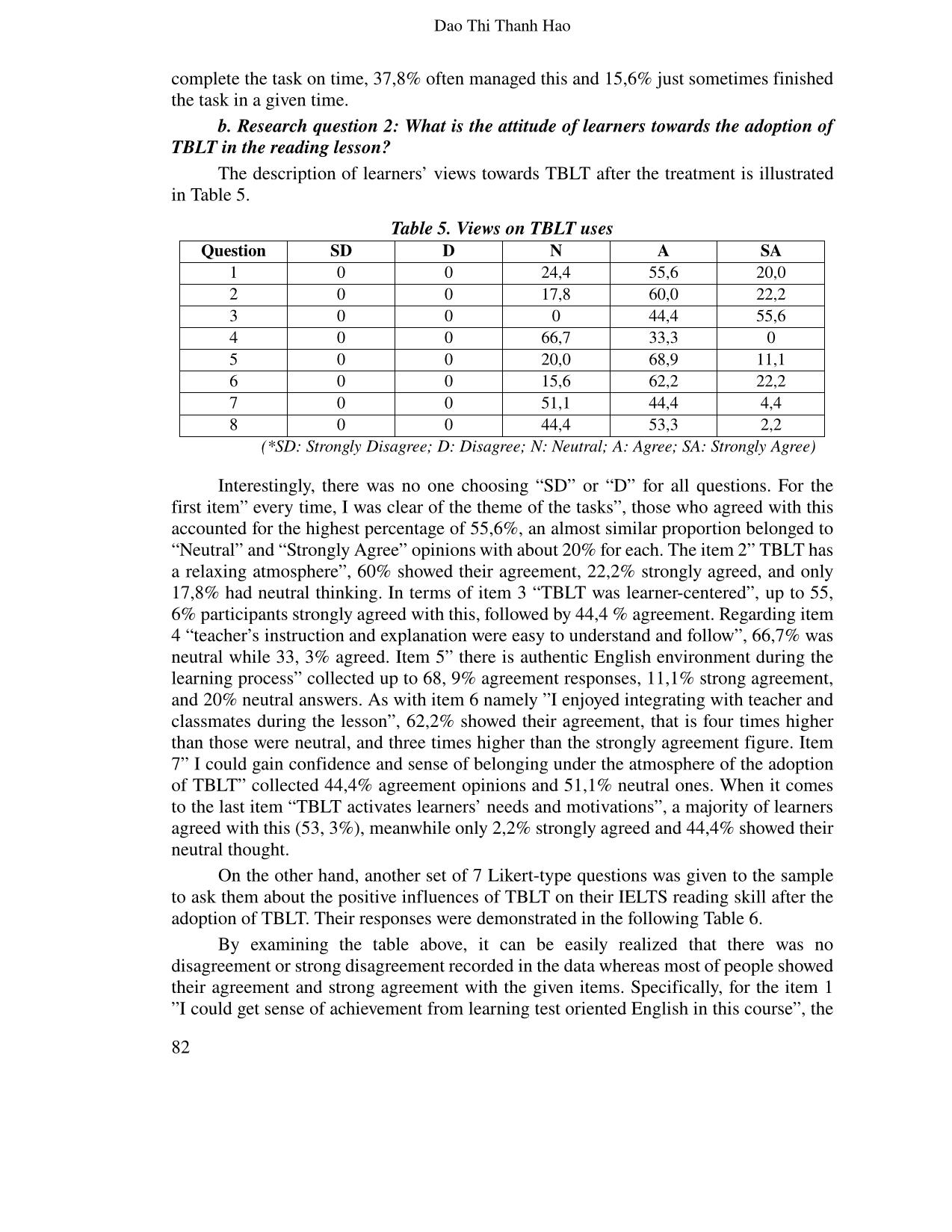
Trang 5
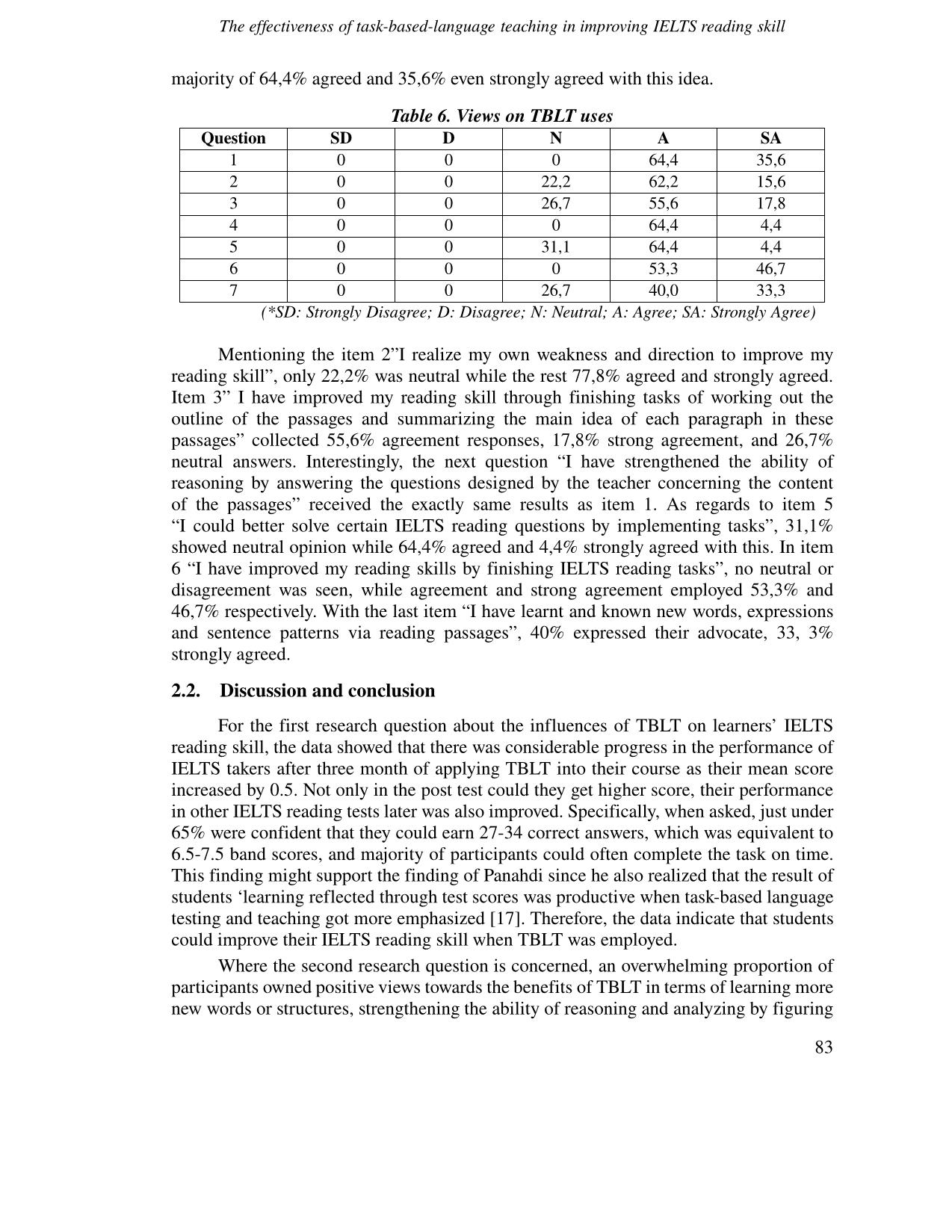
Trang 6
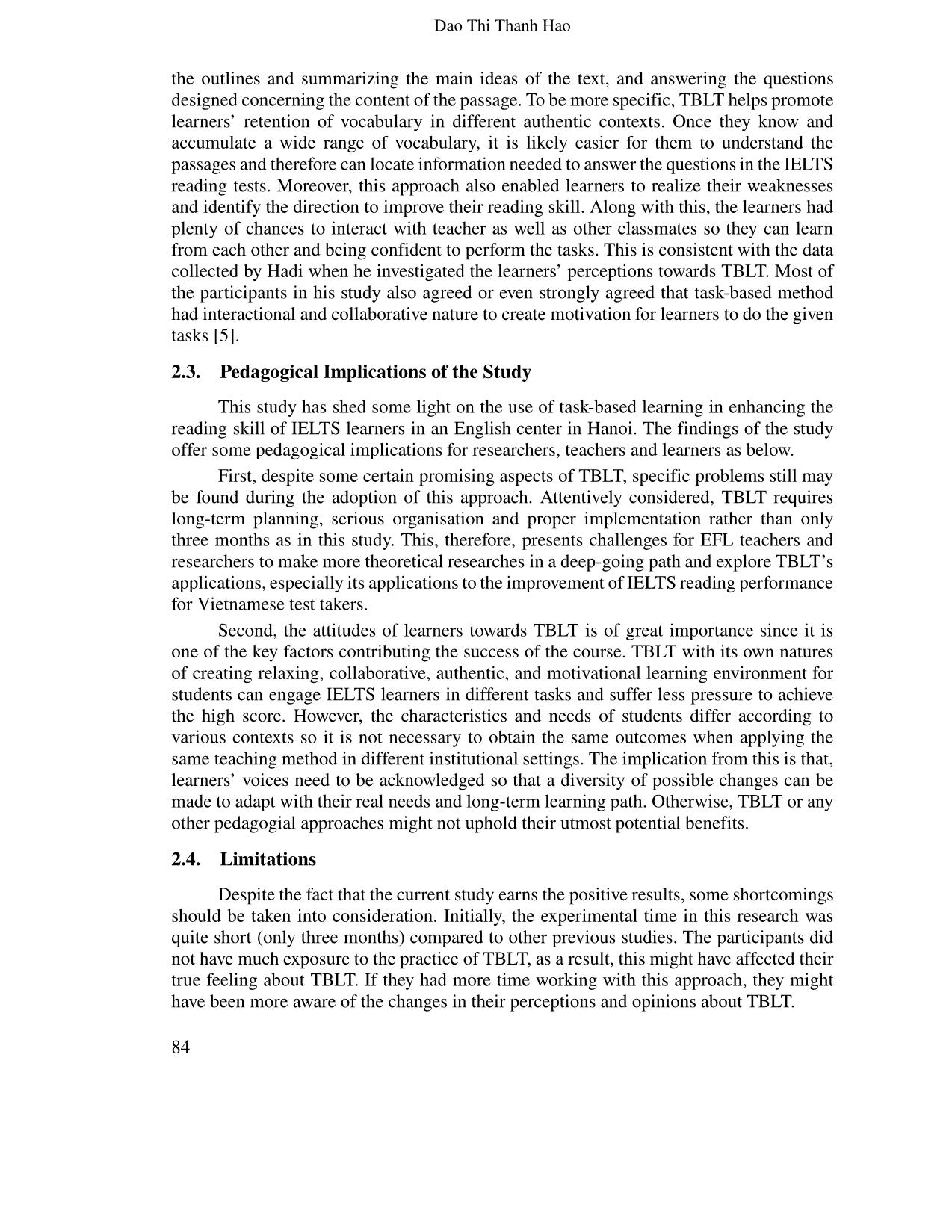
Trang 7
Tóm tắt nội dung tài liệu: The effectiveness of task - based - language teaching in improving ielts reading skill
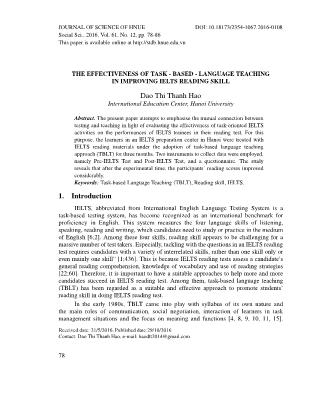
JOURNAL OF SCIENCE OF HNUE DOI: 10.18173/2354-1067.2016-0108 Social Sci., 2016, Vol. 61, No. 12, pp. 78-86 This paper is available online at THE EFFECTIVENESS OF TASK - BASED - LANGUAGE TEACHING IN IMPROVING IELTS READING SKILL Dao Thi Thanh Hao International Education Center, Hanoi University Abstract. The present paper attempts to emphasise the mutual connection between testing and teaching in light of evaluating the effectiveness of task-oriented IELTS activities on the performances of IELTS trainees in their reading test. For this purpose, the learners in an IELTS preparation center in Hanoi were treated with IELTS reading materials under the adoption of task-based language teaching approach (TBLT) for three months. Two instruments to collect data were employed, namely Pre-IELTS Test and Post-IELTS Test, and a questionnaire. The study reveals that after the experimental time, the participants’ reading scores improved considerably. Keywords: Task-based Language Teaching (TBLT), Reading skill, IELTS. 1. Introduction IELTS, abbreviated from International English Language Testing System is a task-based testing system, has become recognized as an international benchmark for proficiency in English. This system measures the four language skills of listening, speaking, reading and writing, which candidates need to study or practice in the medium of English [6;2]. Among these four skills, reading skill appears to be challenging for a massive number of test takers. Especially, tackling with the questions in an IELTS reading test requires candidates with a variety of interrelated skills, rather than one skill only or even mainly one skill” [1;436]. This is because IELTS reading tests assess a candidate’s general reading comprehension, knowledge of vocabulary and use of reading strategies [22;60]. Therefore, it is important to have a suitable approaches to help more and more candidates succeed in IELTS reading test. Among them, task-based language teaching (TBLT) has been regarded as a suitable and effective approach to promote students’ reading skill in doing IELTS reading test. In the early 1980s, TBLT came into play with syllabus of its own nature and the main roles of communication, social negotiation, interaction of learners in task management situations and the focus on meaning and functions [4, 8, 9, 10, 11, 15]. Received date: 21/5/2016, Published date:29/10/2016 Contact: Dao Thi Thanh Hao, e-mail: haodtt2014@gmail.com 78 The effectiveness of task-based-language teaching in improving IELTS reading skill The approach has been defined in a number of ways by various linguistics, educators, and researchers. Long owned a non-pedagogical definition of this terms as “a task is a piece of work undertaken for oneself or for others freely or for some rewards. In other words, task is meant anything people do in everyday life at work, at play, and in between“[12;89]. By contrast, Richards, Platt, and Weber defined TBLT in a more linguistic and pedagogical way when assuming a task as “an activity or action which is a result of understanding and processing the target language” [19;289]. This seems to be in line with what Prabhu defined, i.e. “an activity which required learners to arrive at an outcome from given information through some process of thought, and which allowed teachers to control and regulate that process” [18;44]. Nunan even made it clear when stating that by implementing a task, learners “get involved in comprehension, manipulating, producing, or interacting in the target language with the main focus on meaning rather on form” [16;10]. In this study, the definition of Nunan, and Richards, Platt, and Weber are underpinned the meaning of “task” in the reading lessons. Specifically, the reading “task” in the current paper is defined as a reading classroom activities that involve learners in interacting with each other, comprehending the reading materials, producing their language output based on their comprehension of the materials under the support of the teacher. The significance of TBLT in teaching reading skill has been researched and well-documented by a numerous researchers and teacher-practitioners. Regarding the first, during performing the task, students analyze the new words in different contexts and in different ways so it will reinforce their learning of vocabulary and language uses [14, 15, 21, 23, 24]. This is obviously useful for IELTS learners since each reading passage in IELTS reading test is set in various contexts, and usually extracted from authentic sources like magazine, books, newspapers, or journals. As regards to the second benefit, TBLT engages learners into cognitive process so they can properly comprehend the texts which are extracted from authentic materials [15, 19, 20]. Richards, Platt, and Weber explicitly referred cognitive process to “processing and understanding language” underlying several definitions [19; 289]. These studies were conducted in different contexts and have provided invaluable insights into the practice of TBLT in reading teaching. However, the importance of this approach in improving IELTS reading skill has not been much exploited by many scholars. Therefore, this paper is an attempt to investigate the positive effects of IELTS-oriented tasks on the performance of candidates in their reading test. Two main research questions guided the analysis as follows: (1) What are the influences of TBLT on the learners’ IELTS reading skill? (2) What is the attitude of learners towards the adoption of TBLT in the IELTS reading lesson? 2. Content 2.1. Methodology 2.1.1. Participants 79 Dao Thi Thanh Hao The subjects of this study were 45 students consisting of 28 females and 17 males studying in an IELTS preparation course at an English center in Hanoi. They were at different ages ranging from 16 to 27 but their English proficiency was at pre-intermediate level or above with the aim that they can deal with the difficulty level of the IELTS exam content. Some learners’ data before and after the treatment were set aside and disregarded in order to avoid the intervening variables associated with this project. 2.1.2. Data collection and procedures Data were collected through questionnaires, Pre-IELTS test and Post-IELTS test to obtain the finding about the attitude of the participants towards the use of TBLT in improving their IELTS reading skill and the positive changes (if possible) between the time before and after the treatment with TBLT. First, the pre-test of IELTS reading was delivered to the participants for diagnosis purpose and homogeneity purpose of ascertaining the sample’s reading knowledge. After that, the learners were taught with IELTS reading materials under the adoption of TBLT for three months before they took the post-IELTS reading test. All of these tests were chosen from the book called Cambridge IELTS 10 [2] which all of the participants had never done before the time the current research was conducted. The questionnaires were administered at the conclusion of the study to collect the information about the attitudes of the learners after the treatment with TBLT in their IELTS reading lessons. The questionnaires were adapted from Nunan for evaluating communicative tasks, including 20 questions divided into three sections [16]. The first section contained demographic questions to collect information about learners’ age, sex, and reading ability level. The second part was a 10 Likert-type item set, asking participants about their view on the uses of TBLT during lessons. They had to answer the questions by using a 5-point scale ranging from “strongly disagree” to “strongly agree”. The last section was 3 multiple choice questions about learners’ performance in reading test and also another 7 Likert-type questions about the influences of TBLT on their IELTS reading test results. 2.1.3. Data analysis & results a. Research question 1: What are the influences of TBLT on the learners’ reading skill? A pre-test and post-test of IELTS reading were organized at the commencement and conclusion of the study to compare the students’ results and to calculate the possible effects of TBLT treatment on their IELTS reading performance. The results are shown in two tables, as follows: Table 1. Paired Samples Statistics Pair 1 Mean N Std Deviation Std. Error Mean T1 Pretest 6,156 45 ,4864 ,0725 T2 Posttest 6,611 45 ,4509 ,0672 In light of Table 1, it can be seen that the score mean of the pre-test was considerable 80 The effectiveness of task-based-language teaching in improving IELTS reading skill lower than that of the post-test (6.156 compared to 6.611). It is notable that to increase 0.5 in the IELTS score is not an easy task with IELTS learners. Besides, in the Table 2, the sig. (2- tailed) = 0,000<0, 05; which means that there was a relative difference between 2 test scores. This points out the pedagogical fact that TBLT approach somehow affected the performance of the participants in the study. Table 2. Paired Samples Test Pair 1 Paired Differences t df Sig. (2-talled) Mean Std. Deviation Std. Error Mean 95% Confidence Interval of the Difference (Lower) 95% Confidence Interval of the Difference (Upper) T1 Pretest/ T2 Posttest -,4556 ,4104 ,0612 -,5789 -,3323 -7,446 44 ,000 Moreover, two questions were also designed to investigate the average number of correct answers that the participants got in the IELTS reading tests after three month period of applying TBLT, and the time they completed the test. The results are illustrated clearly in the Table 3 and Table 4: Table 3. Correct answer number Valid Frequence Percent Valid Percent Cumulative Percent 215-26 16 45 35,6 35,6 327-34 29 64,4 64,4 100,0 Total 45 100,0 100,0 As can be seen, up to 64, 4% learners got around 27-34 correct answers in an IELTS reading test, and almost half of that (35, 6%) earned 15-26 ones. Notably, no one could reach the highest figure of 40, and no one got under 15 correct answers. Table 4. Complete a test ontime Valid Frequence Percent Valid Percent Cumulative Percent 2 sometimes 7 15,6 15,6 15,6 3 often 17 37,8 37,8 53,3 4 always 21 46,7 46,7 100,0 Total 45 100,0 100,0 In this table, out of 45 participants in the samples, 46,7% of them could always 81 Dao Thi Thanh Hao complete the task on time, 37,8% often managed this and 15,6% just sometimes finished the task in a given time. b. Research question 2: What is the attitude of learners towards the adoption of TBLT in the reading lesson? The description of learners’ views towards TBLT after the treatment is illustrated in Table 5. Table 5. Views on TBLT uses Question SD D N A SA 1 0 0 24,4 55,6 20,0 2 0 0 17,8 60,0 22,2 3 0 0 0 44,4 55,6 4 0 0 66,7 33,3 0 5 0 0 20,0 68,9 11,1 6 0 0 15,6 62,2 22,2 7 0 0 51,1 44,4 4,4 8 0 0 44,4 53,3 2,2 (*SD: Strongly Disagree; D: Disagree; N: Neutral; A: Agree; SA: Strongly Agree) Interestingly, there was no one choosing “SD” or “D” for all questions. For the first item” every time, I was clear of the theme of the tasks”, those who agreed with this accounted for the highest percentage of 55,6%, an almost similar proportion belonged to “Neutral” and “Strongly Agree” opinions with about 20% for each. The item 2” TBLT has a relaxing atmosphere”, 60% showed their agreement, 22,2% strongly agreed, and only 17,8% had neutral thinking. In terms of item 3 “TBLT was learner-centered”, up to 55, 6% participants strongly agreed with this, followed by 44,4 % agreement. Regarding item 4 “teacher’s instruction and explanation were easy to understand and follow”, 66,7% was neutral while 33, 3% agreed. Item 5” there is authentic English environment during the learning process” collected up to 68, 9% agreement responses, 11,1% strong agreement, and 20% neutral answers. As with item 6 namely ”I enjoyed integrating with teacher and classmates during the lesson”, 62,2% showed their agreement, that is four times higher than those were neutral, and three times higher than the strongly agreement figure. Item 7” I could gain confidence and sense of belonging under the atmosphere of the adoption of TBLT” collected 44,4% agreement opinions and 51,1% neutral ones. When it comes to the last item “TBLT activates learners’ needs and motivations”, a majority of learners agreed with this (53, 3%), meanwhile only 2,2% strongly agreed and 44,4% showed their neutral thought. On the other hand, another set of 7 Likert-type questions was given to the sample to ask them about the positive influences of TBLT on their IELTS reading skill after the adoption of TBLT. Their responses were demonstrated in the following Table 6. By examining the table above, it can be easily realized that there was no disagreement or strong disagreement recorded in the data whereas most of people showed their agreement and strong agreement with the given items. Specifically, for the item 1 ”I could get sense of achievement from learning test oriented English in this course”, the 82 The effectiveness of task-based-language teaching in improving IELTS reading skill majority of 64,4% agreed and 35,6% even strongly agreed with this idea. Table 6. Views on TBLT uses Question SD D N A SA 1 0 0 0 64,4 35,6 2 0 0 22,2 62,2 15,6 3 0 0 26,7 55,6 17,8 4 0 0 0 64,4 4,4 5 0 0 31,1 64,4 4,4 6 0 0 0 53,3 46,7 7 0 0 26,7 40,0 33,3 (*SD: Strongly Disagree; D: Disagree; N: Neutral; A: Agree; SA: Strongly Agree) Mentioning the item 2”I realize my own weakness and direction to improve my reading skill”, only 22,2% was neutral while the rest 77,8% agreed and strongly agreed. Item 3” I have improved my reading skill through finishing tasks of working out the outline of the passages and summarizing the main idea of each paragraph in these passages” collected 55,6% agreement responses, 17,8% strong agreement, and 26,7% neutral answers. Interestingly, the next question “I have strengthened the ability of reasoning by answering the questions designed by the teacher concerning the content of the passages” received the exactly same results as item 1. As regards to item 5 “I could better solve certain IELTS reading questions by implementing tasks”, 31,1% showed neutral opinion while 64,4% agreed and 4,4% strongly agreed with this. In item 6 “I have improved my reading skills by finishing IELTS reading tasks”, no neutral or disagreement was seen, while agreement and strong agreement employed 53,3% and 46,7% respectively. With the last item “I have learnt and known new words, expressions and sentence patterns via reading passages”, 40% expressed their advocate, 33, 3% strongly agreed. 2.2. Discussion and conclusion For the first research question about the influences of TBLT on learners’ IELTS reading skill, the data showed that there was considerable progress in the performance of IELTS takers after three month of applying TBLT into their course as their mean score increased by 0.5. Not only in the post test could they get higher score, their performance in other IELTS reading tests later was also improved. Specifically, when asked, just under 65% were confident that they could earn 27-34 correct answers, which was equivalent to 6.5-7.5 band scores, and majority of participants could often complete the task on time. This finding might support the finding of Panahdi since he also realized that the result of students ‘learning reflected through test scores was productive when task-based language testing and teaching got more emphasized [17]. Therefore, the data indicate that students could improve their IELTS reading skill when TBLT was employed. Where the second research question is concerned, an overwhelming proportion of participants owned positive views towards the benefits of TBLT in terms of learning more new words or structures, strengthening the ability of reasoning and analyzing by figuring 83 Dao Thi Thanh Hao the outlines and summarizing the main ideas of the text, and answering the questions designed concerning the content of the passage. To be more specific, TBLT helps promote learners’ retention of vocabulary in different authentic contexts. Once they know and accumulate a wide range of vocabulary, it is likely easier for them to understand the passages and therefore can locate information needed to answer the questions in the IELTS reading tests. Moreover, this approach also enabled learners to realize their weaknesses and identify the direction to improve their reading skill. Along with this, the learners had plenty of chances to interact with teacher as well as other classmates so they can learn from each other and being confident to perform the tasks. This is consistent with the data collected by Hadi when he investigated the learners’ perceptions towards TBLT. Most of the participants in his study also agreed or even strongly agreed that task-based method had interactional and collaborative nature to create motivation for learners to do the given tasks [5]. 2.3. Pedagogical Implications of the Study This study has shed some light on the use of task-based learning in enhancing the reading skill of IELTS learners in an English center in Hanoi. The findings of the study offer some pedagogical implications for researchers, teachers and learners as below. First, despite some certain promising aspects of TBLT, specific problems still may be found during the adoption of this approach. Attentively considered, TBLT requires long-term planning, serious organisation and proper implementation rather than only three months as in this study. This, therefore, presents challenges for EFL teachers and researchers to make more theoretical researches in a deep-going path and explore TBLT’s applications, especially its applications to the improvement of IELTS reading performance for Vietnamese test takers. Second, the attitudes of learners towards TBLT is of great importance since it is one of the key factors contributing the success of the course. TBLT with its own natures of creating relaxing, collaborative, authentic, and motivational learning environment for students can engage IELTS learners in different tasks and suffer less pressure to achieve the high score. However, the characteristics and needs of students differ according to various contexts so it is not necessary to obtain the same outcomes when applying the same teaching method in different institutional settings. The implication from this is that, learners’ voices need to be acknowledged so that a diversity of possible changes can be made to adapt with their real needs and long-term learning path. Otherwise, TBLT or any other pedagogial approaches might not uphold their utmost potential benefits. 2.4. Limitations Despite the fact that the current study earns the positive results, some shortcomings should be taken into consideration. Initially, the experimental time in this research was quite short (only three months) compared to other previous studies. The participants did not have much exposure to the practice of TBLT, as a result, this might have affected their true feeling about TBLT. If they had more time working with this approach, they might have been more aware of the changes in their perceptions and opinions about TBLT. 84
File đính kèm:
 the_effectiveness_of_task_based_language_teaching_in_improvi.pdf
the_effectiveness_of_task_based_language_teaching_in_improvi.pdf

